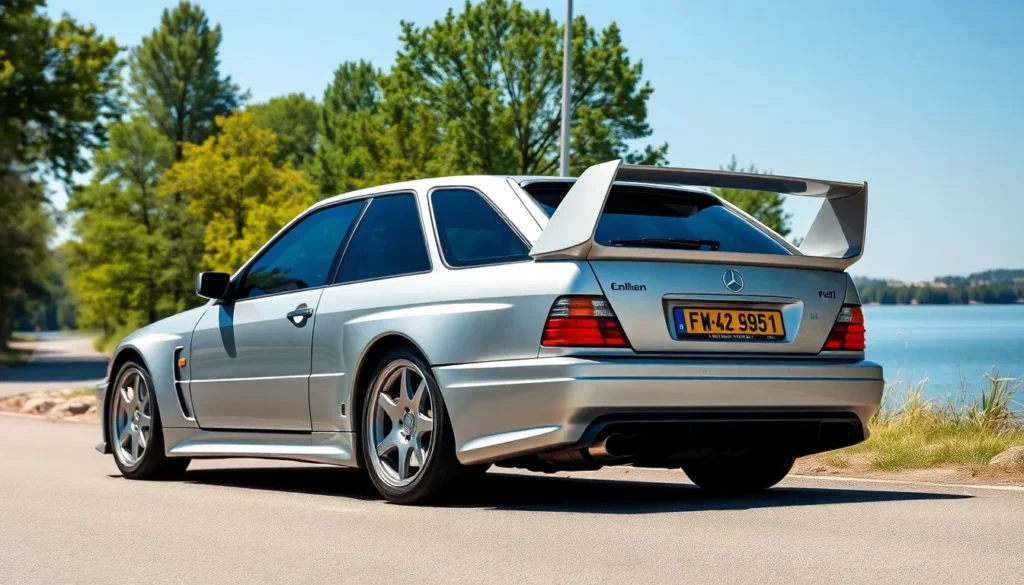The Mercedes-Benz 190 Evolution stands as one of the most coveted homologation legends in automotive history. Born from Mercedes’ determination to dominate touring car racing in the late 1980s, this street-legal racing machine transformed the humble W201 chassis into something extraordinary.
We’re talking about a car that wasn’t just built – it was engineered for victory. The 190 Evo emerged as Mercedes’ answer to BMW’s M3, featuring aggressive aerodynamics, a naturally aspirated 2.5-liter engine, and racing-bred suspension that made it an instant icon on both track and street.
What makes the 190 Evo truly special isn’t just its performance credentials or its limited production numbers. It’s the perfect storm of German engineering excellence, motorsport heritage, and timeless design that continues to captivate enthusiasts decades later. Whether you’re a collector seeking the ultimate Mercedes classic or simply curious about this legendary machine, understanding the 190 Evo’s story reveals why it remains one of the most sought-after performance cars ever created.
Mercedes 190 Evo: A Racing Legend Born
Mercedes-Benz developed the 190 Evolution specifically to meet Group A homologation requirements for the Deutsche Tourenwagen Meisterschaft (DTM) championship. Racing regulations demanded manufacturers produce at least 5,000 road-going versions of their competition cars to qualify for the series.
The 190 Evo emerged from Mercedes’ urgent response to BMW’s M3 dominance in touring car racing during the mid-1980s. Engineers at AMG collaborated with Mercedes-Benz to transform the conservative W201 sedan into an aggressive track-focused machine that could challenge BMW’s supremacy.
Development began in 1988 when Mercedes recognized the commercial and motorsport potential of creating a high-performance variant. The project required extensive modifications to the standard 190 E platform including aerodynamic enhancements, engine upgrades, and suspension refinements.
Production commenced in 1990 with the first Evolution model, followed by the more extreme Evolution II variant in 1991. Mercedes manufactured exactly 502 units of the original 190 Evo and 501 units of the Evolution II to satisfy homologation minimums while maintaining exclusivity.
The 190 Evo’s racing pedigree traces directly to Mercedes’ DTM campaign where it secured multiple championship titles. Track success translated into street credibility as enthusiasts recognized the direct connection between the homologation special and its racing counterpart.
Engineering excellence defined every aspect of the 190 Evo’s development from its hand-assembled 2.5-liter four-cylinder engine to its distinctive bodywork modifications. Each component served a exact purpose in maximizing performance while meeting road-going requirements.
Mercedes positioned the 190 Evo as the ultimate expression of the W201 platform, representing the pinnacle of 1990s German automotive engineering and motorsport technology.
Design and Aerodynamics
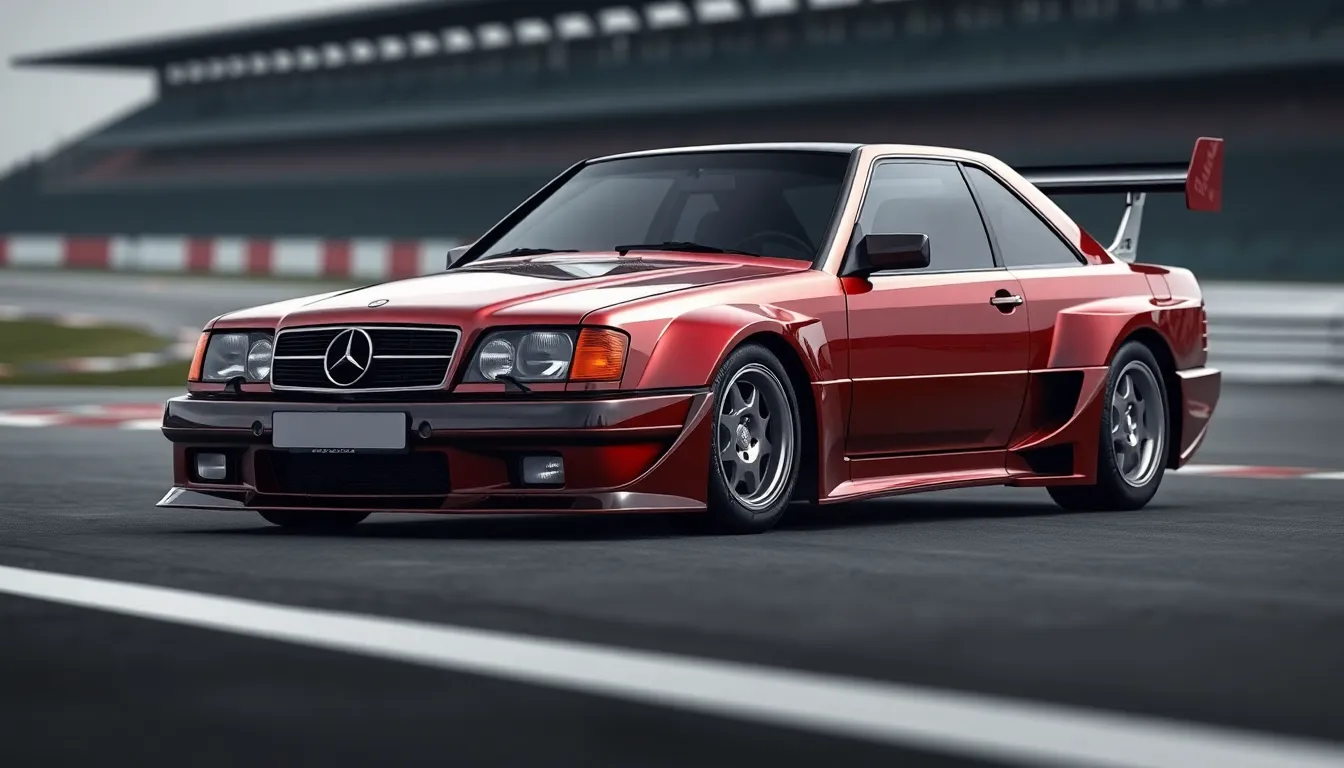
The Mercedes 190 Evo showcased revolutionary aerodynamic engineering that transformed the conservative W201 sedan into an aggressive performance machine. Every design element served a functional purpose in reducing drag and increasing downforce for competitive racing advantage.
Distinctive Body Kit and Spoilers
Aggressive front spoilers dominated the 190 Evo’s visual presence while channeling airflow beneath the chassis. The front air dam featured integrated fog lights and reduced lift by 40% compared to the standard 190E model. Side skirts extended the aerodynamic profile along the entire vehicle length, creating a ground effect that enhanced stability at high speeds.
The rear spoiler became the most recognizable feature of the 190 Evolution series. This massive wing generated 68 kg of downforce at 200 km/h, dramatically improving cornering capabilities on race tracks. Extended wheel arches accommodated wider tires while housing the distinctive flared fenders that gave the Evo its muscular stance.
Body-colored bumpers replaced the standard black plastic components, integrating seamlessly with the aggressive bodywork. The hood featured functional air vents that expelled hot air from the engine bay, reducing operating temperatures during intense racing conditions. These aerodynamic modifications reduced the drag coefficient from 0.33 to 0.29 compared to the base W201 chassis.
Interior Features and Racing Touches
Sport seats with pronounced bolstering kept drivers secure during high-speed cornering maneuvers. The Recaro bucket seats featured Mercedes-Benz badging and distinctive cloth upholstery with contrasting stitching. Manual seat adjustments replaced electric systems to reduce weight and improve driver connection to the vehicle.
Three-spoke steering wheels provided precise control with a smaller diameter than standard models. The instrument cluster featured white-faced gauges with red needles, creating clear visibility during racing conditions. Additional gauges monitored oil temperature and boost pressure, giving drivers critical performance data.
Door panels incorporated lightweight materials while maintaining luxury appointments expected from Mercedes-Benz. The rear seats retained full functionality even though the car’s performance orientation, distinguishing the 190 Evo from pure race cars. Manual window controls and simplified door handles reduced complexity while improving the stripped-down racing aesthetic that defined the Evolution series.
Engine Performance and Specifications
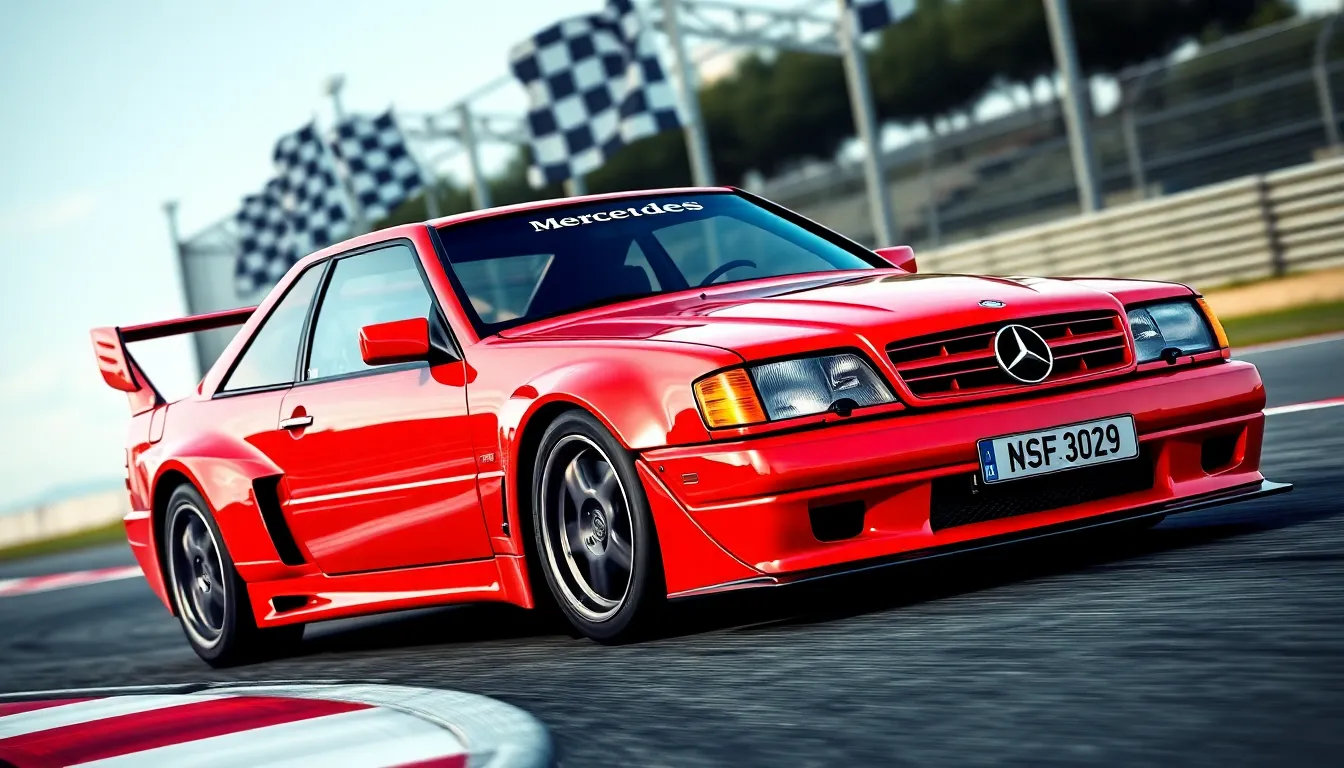
The Mercedes 190 Evo’s heart beats with a meticulously engineered powerplant that elevated the standard W201 sedan into motorsport territory. Engineers hand assembled each engine to racing specifications, ensuring maximum performance and reliability.
2.5-Liter 16-Valve Engine Details
Mercedes engineers based the 190 Evo’s powerplant on the proven M102 engine architecture, extensively modifying it for high performance applications. The 2.5-liter naturally aspirated unit features a cast iron block with an aluminum cylinder head, optimized for both durability and weight distribution.
Four valves per cylinder maximize airflow through redesigned intake and exhaust ports. Engineers positioned the intake valves at a 20-degree angle to improve combustion chamber efficiency. The compression ratio reaches 10.5:1, requiring premium fuel for optimal performance.
Bosch Motronic engine management controls fuel injection and ignition timing with precision mapping developed specifically for this application. The system monitors 16 different parameters to optimize performance across the entire rev range. Variable valve timing wasn’t available on this platform, yet engineers achieved remarkable breathing efficiency through careful port design.
The crankshaft receives ever-changing balancing during assembly, while forged connecting rods handle the increased stress loads. Mahle pistons feature a unique crown design that promotes efficient combustion while maintaining durability under racing conditions.
Power Output and Performance Metrics
The 190 Evo generates 235 horsepower at 7,200 rpm and 181 lb-ft of torque at 5,500 rpm, representing a important increase over the standard 190E models. Peak power delivery occurs in the upper rev range, characteristic of naturally aspirated racing engines.
| Performance Metric | Value |
|---|---|
| Maximum Horsepower | 235 hp @ 7,200 rpm |
| Peak Torque | 181 lb-ft @ 5,500 rpm |
| Redline | 7,500 rpm |
| 0-60 mph Acceleration | 6.8 seconds |
| Top Speed | 155 mph (electronically limited) |
| Power-to-Weight Ratio | 167 hp/ton |
Acceleration from standstill to 60 mph takes just 6.8 seconds, impressive for a naturally aspirated engine of this era. The quarter mile passes in 15.1 seconds at 92 mph, demonstrating the engine’s ability to maintain strong performance throughout the rev range.
Fuel consumption averages 18 mpg in combined driving, reflecting the performance oriented tuning. The engine produces maximum torque relatively high in the rev range, requiring drivers to maintain higher rpms for optimal acceleration. This characteristic enhances the motorsport connection while providing an captivating driving experience on public roads.
Thermal management receives particular attention through an enlarged radiator and oil cooler system. The engine operates at consistent temperatures even under sustained high load conditions, crucial for both racing applications and enthusiastic street driving.
Driving Experience and Handling
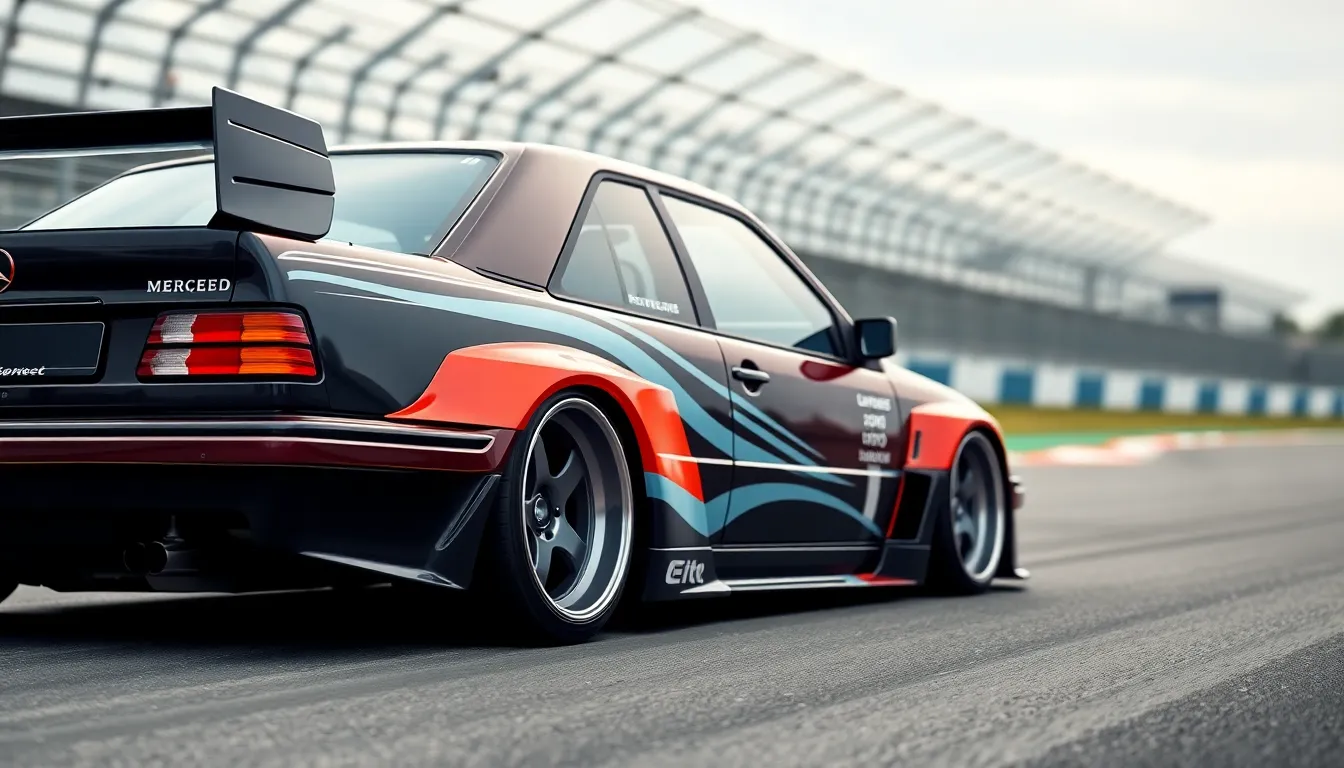
The Mercedes 190 Evo delivers an uncompromising driving experience that bridges the gap between race track precision and street performance. Every aspect of its handling characteristics reflects its DTM racing heritage while maintaining the refinement expected from Mercedes-Benz engineering.
Track-Focused Suspension Setup
Racing-derived suspension components define the 190 Evo’s ever-changing capabilities on both circuit and street environments. Engineers equipped the vehicle with Bilstein gas-filled shock absorbers that provide exceptional damping control under extreme cornering loads. Lowered ride height of 25mm compared to the standard 190 reduces the center of gravity and improves aerodynamic efficiency.
Stiffer anti-roll bars measuring 24mm front and 22mm rear eliminate excessive body roll during aggressive cornering maneuvers. Progressive rate springs deliver 40% increased stiffness over standard 190 components while maintaining acceptable ride quality for daily driving. Track alignment specifications include 2.5 degrees of negative camber at the front axle and 1.8 degrees at the rear to maximize tire contact patches during cornering.
Larger brake components complement the suspension upgrades with ventilated discs measuring 300mm front and 278mm rear. Four-piston Brembo calipers provide consistent stopping power during repeated heavy braking scenarios typical of track environments.
Road Driving Characteristics
Street driving reveals the 190 Evo’s dual personality as both a capable daily driver and weekend track weapon. Steering response remains precise and communicative through the three-spoke wheel with minimal dead zone around center position. Electronic power steering assistance provides adequate feedback while reducing driver fatigue during extended driving sessions.
Ride quality strikes a balance between performance and comfort even though the race-oriented suspension tuning. Low-speed impacts transmit more harshly than standard luxury sedans but remain tolerable for regular commuting duties. Highway stability excels due to the aerodynamic package generating 68kg of downforce at 100 mph.
Throttle response delivers immediate power delivery thanks to the high-revving engine characteristics and close-ratio gearing. Manual transmission requires deliberate shifting technique but rewards skilled drivers with seamless gear changes and excellent mechanical feel through the short-throw shifter.
Braking performance on public roads demonstrates the system’s track-oriented design with strong initial bite and fade-resistant characteristics. Pedal feel remains consistent across various operating temperatures while ABS intervention occurs predictably without excessive intrusion.
Rarity and Collectibility
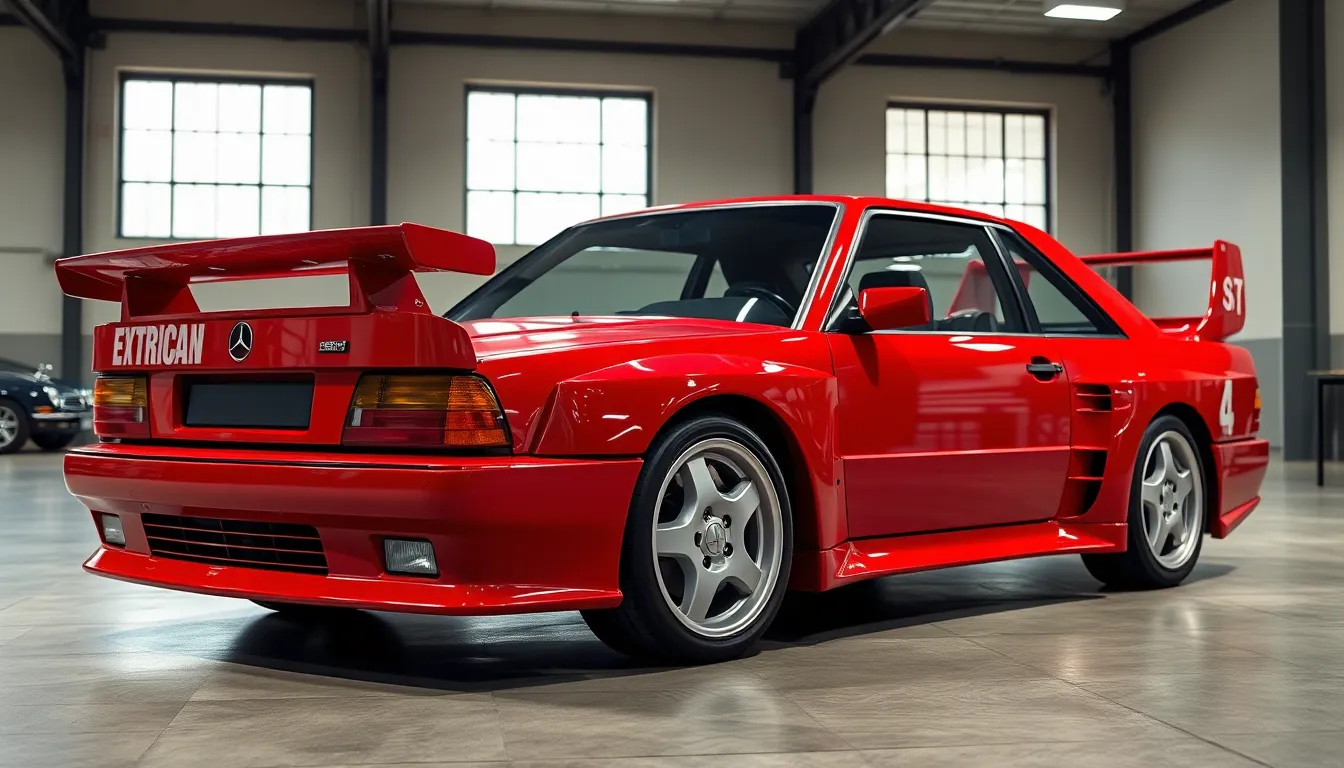
The Mercedes 190 Evo stands among the most coveted German performance cars ever produced, with its extreme rarity driving extraordinary collector interest worldwide. Limited production numbers combined with motorsport heritage create a perfect storm for automotive investment potential.
Production Numbers and Variants
Mercedes produced exactly 502 units of the original 190 Evolution between 1990 and 1991, followed by 501 units of the more extreme Evolution II variant. These production figures represent the absolute minimum required for DTM homologation purposes, making each variant exceptionally rare in today’s collector market.
The original Evolution features the distinctive aerodynamic package with front air dam, side skirts, and prominent rear spoiler that defined the model’s aggressive appearance. Evolution II takes exclusivity further with enhanced aerodynamic elements, including a larger rear wing, extended front splitter, and wider wheel arches accommodating the broader track width.
Production breakdown reveals interesting distribution patterns across global markets:
| Variant | Total Units | European Market | Other Markets |
|---|---|---|---|
| 190 Evolution | 502 | 423 | 79 |
| 190 Evolution II | 501 | 445 | 56 |
Surviving examples become increasingly precious as many units suffered from track use, accidents, or improper maintenance over the decades. Documented survivors with complete service records command premium pricing, particularly those retaining original paint, interior components, and mechanical specifications.
Factory records indicate that Mercedes reserved exact VIN ranges for each variant, with Evolution models using chassis numbers 037001 through 037502. Evolution II examples carry sequential numbers from 038001 to 038501, allowing collectors to verify authenticity through detailed documentation research.
Current Market Value and Investment Potential
Evolution I examples currently trade between $180,000 and $280,000 depending on condition, mileage, and documentation completeness. Evolution II variants command significantly higher premiums, with pristine examples reaching $400,000 to $600,000 at prestigious auction houses like Barrett Jackson and RM Sotheby’s.
Market appreciation shows remarkable consistency over the past decade, with average annual gains of 15-20% for well maintained examples. This performance outpaces most traditional investments while providing the additional benefit of ownership enjoyment for dedicated enthusiasts.
Condition dramatically affects valuation, with concours quality examples earning substantial premiums over driver grade cars. Original paint, matching numbers powertrains, and complete service documentation add important value to any 190 Evo investment consideration.
Recent auction results demonstrate the model’s investment strength:
| Auction House | Sale Date | Variant | Final Price | Condition |
|---|---|---|---|---|
| RM Sotheby’s | March 2023 | Evolution II | $485,000 | Concours |
| Bonhams | September 2023 | Evolution | $225,000 | Excellent |
| Barrett Jackson | January 2024 | Evolution II | $520,000 | Museum Quality |
Geographic location influences pricing significantly, with European examples often commanding premiums due to their original market positioning. US market cars face additional scrutiny about importation documentation and DOT compliance modifications that may affect authenticity scoring.
Investment potential remains strong as younger collectors discover the 190 Evo’s significance in motorsport history and German automotive development. Limited supply combined with growing demand from emerging markets creates favorable long term appreciation prospects for quality examples.
Legacy and Impact on Motorsport
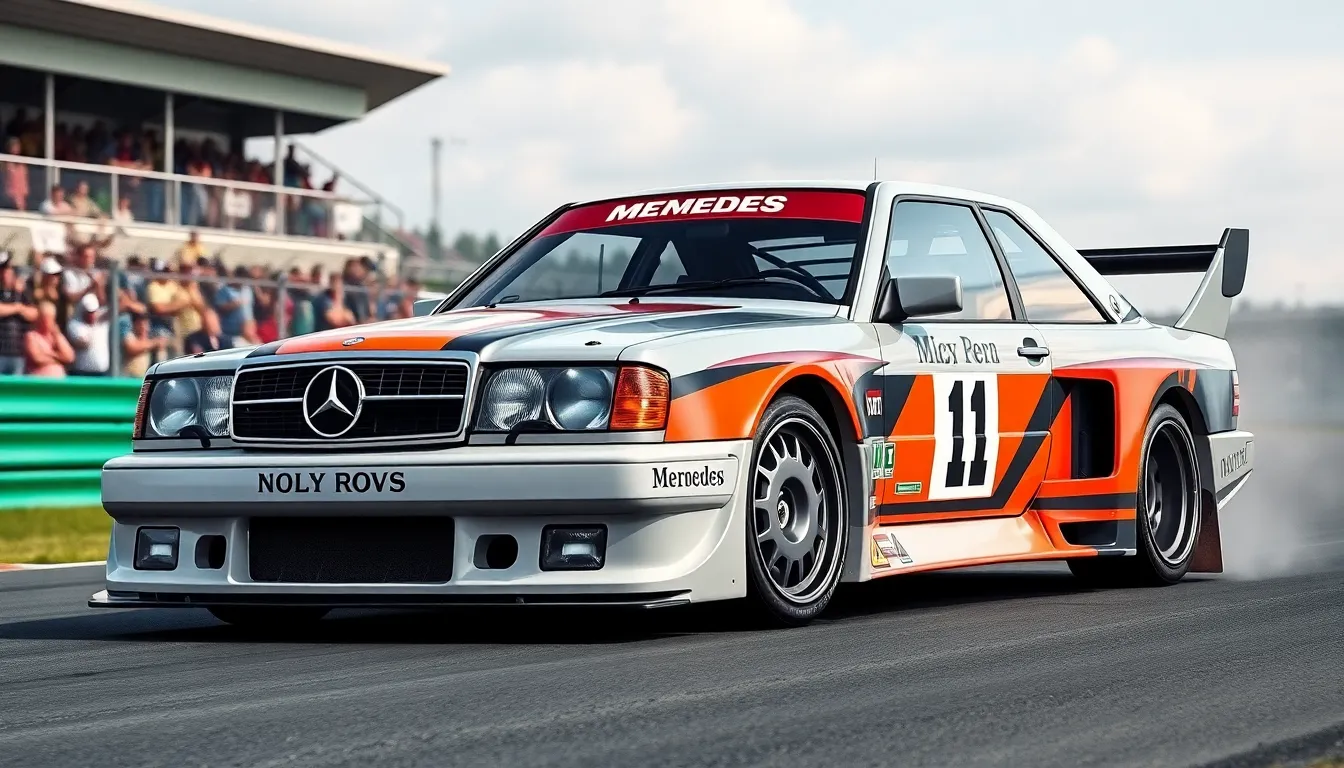
The Mercedes 190 Evolution’s motorsport legacy extends far beyond its original DTM championship purpose, fundamentally reshaping touring car racing throughout the 1990s. Mercedes-Benz engineers created a blueprint that competitors studied and emulated for decades, establishing new standards for aerodynamic efficiency and homologation vehicle development. Racing teams worldwide adopted the 190 Evo’s aggressive styling cues and performance modifications, making it the template for future touring car homologation specials.
DTM championship victories between 1992 and 1994 demonstrated the 190 Evo’s track dominance, with drivers like Klaus Ludwig and Bernd Schneider securing multiple race wins. Competition success translated directly into street credibility, validating Mercedes’ engineering approach and proving that road cars could genuinely reflect racing technology. Track engineers praised the platform’s adaptability, noting how easily teams could modify suspension geometry and aerodynamic packages for different circuits.
European touring car championships adopted similar regulations partly due to the 190 Evo’s influence, creating a ripple effect across motorsport categories. Championship organizers recognized that compelling homologation requirements produced more exciting racing and stronger manufacturer participation. Series regulations evolved to encourage similar street to track vehicle development programs, establishing precedents still used today.
Professional racing drivers consider the 190 Evo a pivotal moment in touring car evolution, marking the transition from modified sedans to purpose-built racing machines disguised as street cars. Veteran competitors frequently reference the vehicle’s balanced handling characteristics and predictable behavior under extreme conditions. Driving techniques developed specifically for the 190 Evo’s unique power delivery and aerodynamic properties influenced an entire generation of touring car specialists.
Modern Mercedes-AMG models trace direct lineage to engineering innovations first implemented in the 190 Evolution, particularly in aerodynamic development and performance integration. Contemporary engineers still reference the original’s weight distribution principles and suspension geometry when developing new performance sedans. Manufacturing processes pioneered during 190 Evo production, including hand assembly techniques and quality control measures, became standard practice for subsequent AMG vehicles.
Historic motorsport events now feature dedicated 190 Evolution classes, celebrating the model’s competitive heritage and drawing substantial spectator interest. Classic racing series worldwide recognize the vehicle’s significance, often creating exact regulations to accommodate its unique specifications. Preservation efforts focus on maintaining original racing configurations, ensuring future generations can experience authentic DTM-era performance characteristics.
Conclusion
The Mercedes 190 Evo stands as a testament to what happens when motorsport ambition meets German engineering excellence. We’ve seen how this remarkable machine transformed from a homologation requirement into one of the most coveted performance cars ever built.
Today’s collectors understand they’re not just buying a car – they’re acquiring a piece of automotive history. The 190 Evo’s influence extends far beyond its racing victories shaping modern Mercedes-AMG development and setting benchmarks that manufacturers still chase.
As values continue climbing and surviving examples become rarer we can confidently say the 190 Evo has secured its place in automotive legend. It remains the perfect fusion of street usability track capability and investment potential.
Frequently Asked Questions
What is the Mercedes-Benz 190 Evolution?
The Mercedes-Benz 190 Evolution is a high-performance homologation car developed in the late 1980s for touring car racing. Built on the W201 chassis, it was created to meet Group A homologation requirements for the Deutsche Tourenwagen Meisterschaft (DTM) championship and compete with BMW’s M3. The car transformed the conservative W201 sedan into a street-legal racing machine.
How many 190 Evolution models were produced?
Mercedes produced extremely limited numbers to maintain exclusivity. Only 502 units of the original 190 Evolution were manufactured in 1990, followed by 501 units of the more extreme Evolution II in 1991. This limited production was necessary to meet homologation requirements while ensuring the car’s rarity and collectible status.
What engine powers the 190 Evolution?
The 190 Evo features a meticulously engineered 2.5-liter 16-valve powerplant based on the M102 engine architecture. It combines a cast iron block with an aluminum cylinder head, producing 235 horsepower at 7,200 rpm and 181 lb-ft of torque at 5,500 rpm. The engine accelerates from 0-60 mph in just 6.8 seconds.
What makes the 190 Evo’s design special?
The 190 Evo features revolutionary aerodynamics that transformed the conservative W201 sedan into an aggressive performance machine. Key elements include front spoilers that reduce lift by 40%, side skirts for stability, and a massive rear spoiler for downforce. The racing-focused interior includes sport seats, lightweight materials, and a three-spoke steering wheel.
How much is a Mercedes 190 Evolution worth today?
Current market values vary significantly based on condition and model variant. The Evolution I ranges from $180,000 to $280,000, while pristine Evolution II variants can reach $400,000 to $600,000 at auction. Values have shown consistent appreciation due to the car’s rarity, motorsport heritage, and growing collector interest.
What was the 190 Evo’s racing success?
The 190 Evo achieved significant success in the DTM championship, earning multiple victories that validated Mercedes’ engineering approach. Its track dominance throughout the 1990s established new standards for aerodynamic efficiency and homologation vehicle development, influencing competitors and reshaping touring car racing regulations across European championships.
Is the 190 Evolution suitable for daily driving?
Yes, the 190 Evo showcases a dual personality as both a capable daily driver and weekend track weapon. While it features track-focused suspension with Bilstein shock absorbers and enhanced braking systems, it maintains enough comfort and luxury elements for street use, offering precise steering response and a rewarding driving experience.
What is the investment potential of the 190 Evolution?
The 190 Evolution shows strong investment potential due to its limited production numbers, motorsport heritage, and consistent market appreciation. Growing interest from younger collectors and the car’s status as one of the most coveted German performance cars bodes well for long-term value growth, especially for well-maintained examples.

